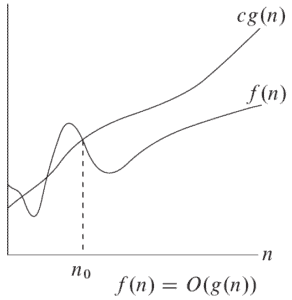1. Overview
In this brief tutorial, we’ll learn about how big-O and little-o notations differ. In short, they are both asymptotic notations that specify upper-bounds for functions and running times of algorithms.
However, the difference is that big-O may be asymptotically tight while little-o makes sure that the upper bound isn’t asymptotically tight.
Let’s read on to understand what exactly it means to be asymptotically tight.
2. Mathematical Definition
Big-O and little-o notations have very similar definitions, and their difference lies in how strict they are regarding the upper bound they represent.
2.1. Big-O
For a given function ,
is defined as:
there exist positive constants
and
such that
for all
.
So is a set of functions that are, after
, smaller than or equal to
. The function’s behavior before
is unimportant since big-O notation (also little-o notation) analyzes the function for huge numbers. As an example, let’s have a look at the following figure:

Here, is only one of the possible functions that belong to
. Before
,
is not always smaller than or equal to
, but after
, it never goes above
.
The equal sign in the definition represents the concept of asymptotical tightness, meaning that when gets very large,
and
grow at the same rate. For instance,
satisfies the equal sign, hence it is asymptotically tight, while
is not.
For more explanation on this notation, look at an introduction to the theory of big-O notation.
2.2. Little-o
Little-o notation is used to denote an upper-bound that is not asymptotically tight. It is formally defined as:
for any positive constant
, there exists positive constant
such that
for all
.
Note that in this definition, the set of functions are strictly smaller than
, meaning that little-o notation is a stronger upper bound than big-O notation. In other words, the little-o notation does not allow the function
to have the same growth rate as
.
Intuitively, this means that as the approaches infinity,
becomes insignificant compared to
. In mathematical terms:
In addition, the inequality in the definition of little-o should hold for any constant , whereas for big-O, it is enough to find some
that satisfies the inequality.
If we drew an analogy between asymptotic comparison of and
and the comparison of real numbers
and
, we would have
while
.
3. Examples
Let’s have a look at some examples to make things clearer.
For , we have:
but
and
and
In general, for , we will have:
but
and
and
For more examples of big-O notation, see practical Java examples of the big-O notation.
4. Conclusion
In this article, we learned the difference between big-O and little-o notations and noted that little-o notation excludes the asymptotically tight functions from the set of big-O functions.